
Every year, Seattle-based author/illustrator Julie Paschkis attends a big neighborhood party hosted by her sister Jan and husband Greg, where family and friends gather to decorate eggs and eat lots of delicious food.

Their eggs, Ukrainian pysanky, are decorated with patterns of beeswax and layers of dye, and are part of a longstanding folk art tradition that honors the Sun and welcomes Spring. Julie’s new picture book P. Zonka Lays An Egg (Peachtree, 2015), which officially hits shelves this week (!), was inspired by these marvelous egg-decorating parties, and is, in a word, GORGEOUS.

P. Zonka herself is no ordinary hen. Unlike her clucky friends Maud, Dora and Nadine, she’s a not a regular egg layer, preferring to spend her days gazing at the wonders of the natural world. Much to the bewilderment of the other hens, who think she’s either daft or just plain lazy, P. Zonka is enthralled by soft dark moss, the deep blue of the sky, pale mornings, and the shining centers of dandelions.
After much pestering, urging and coaxing by the other hens, P. Zonka finally decides to give egg laying a try — and the result is well beyond any could have imagined — in a word, SPECTACULAR!
This vibrant, colorful paean to individuality, creativity and imagination is pure joy personified. Julie’s lush and lyrical illustrations, with their loose, sweeping curves and bright yellows, greens, blues and pinks embody P. Zonka’s free spirit and burst forth with vernal images of sunlight, grass, flowers, stems, vines, leaves, bees, and butterflies evocative of traditional folk motifs. The plucky clucky hens brim with personality, as does Gloria the Rooster, a champion crower who greets the rising sun with aplomb and showy tail feathers.


Each dazzling spread is a visual poem, making the heart sing with the wonder of rebirth, new life, and the unvarnished beauty of nature. The preponderance of warm buttery yellows instantly lifts the spirit, a fitting salute to the life-sustaining sun. And truly, that dramatic page turn where P. Zonka’s egg is finally revealed will no doubt elicit enthusiastic wow’s from readers of all ages, a stunning reminder that good things are worth waiting for.
I’m so happy Julie is here today to tell us more about P. Zonka, and I thank her for sharing party photos, art, and a yummy recipe for kulich, a Russian Easter bread/coffee cake that calls for 9 egg yolks. She kindly baked some just for us! Mmmmm!

* * *
☼ HEN TALK WITH JULIE PASCHKIS ☼
 Is P. Zonka your alter ego? Where did the idea for a day-dreamy, creative, non-conformist chicken come from?
Is P. Zonka your alter ego? Where did the idea for a day-dreamy, creative, non-conformist chicken come from?
Well – I do have a lot of P. Zonka in me. I love to doodle and daydream. But I think most of us are a blend of chickens! I would rather be more like P. Zonka than the others, but my inner Nadine does help me get things done. I tend to push myself pretty hard and work a lot. But a lot of my ideas come when I let go and wander. So P. Zonka had some advice to give me.
When it comes to pysanky, what are some of your favorite colors, patterns and ornamental motifs, and what do they symbolize? Do you consciously think about the symbolism behind these elements when planning an egg’s decoration?
I have read about the symbolism and find it fascinating. I don’t make completely traditional eggs, but I am inspired by them. Some of the symbols are trees, birds, spiders, flowers and wheat. There is a book called Ukrainian Easter Eggs by Kmit, Luchow and Perchyshyn that contains lots of information and instruction.
Here is a legend from that book about the first pysanky: During a harsh winter many birds fell frozen and hungry into the fields. The peasants took the birds into their homes and cared for them. When spring arrived they released the birds. The birds flew away, then returned a few days later with pysanky for their human helpers.

Tell us more about the annual egg painting parties at Jan and Greg’s. Are there any customs, rituals, or designs exclusive to your family group?
My sister always begins the party by reading “Ode to an Egg.”
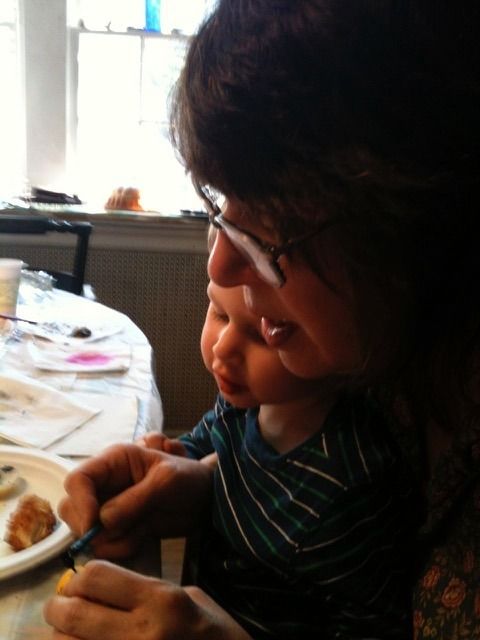
Julie’s sister Jan showing her grandson Benji how to make pysanky.
ODE TO AN EGG
by Clarence DayOh who that ever lived and loved
Can look upon an egg unmoved?
The egg it is the source of all.
‘Tis everyone’s ancestral hall.
The bravest chief that ever fought,
The lowest thief that e’er was caught,
The harlot’s lip, the maiden’s leg,
They each and all came from an egg.The rocks that once by ocean’s surge
Beheld the first of eggs emerge —
Obscure, defenseless, small and cold —
They little knew what an egg could hold.
The gifts the reverent Magi gave,
Pandora’s box, Aladdin’s cave,
Wars, loves, and kingdoms,
heaven and hell
All lay within that tiny shell.Oh join me gentle friends, I beg,
In honoring our friend, the egg.
*
Everyone’s eggs are different, and over the years people have developed their own styles.




Please tell us about your favorite egg from all the ones you’ve decorated so far. Do you usually have specific recipients in mind for your pysanky?
I make eggs for friends and family. My favorite egg is usually the one that I am working on at that moment. It feels like magic when you remove the layers of wax. I often explore one theme for a while – one year I made a lot of simple striped eggs, another year it was faces, another year there were squirrels and acorns.
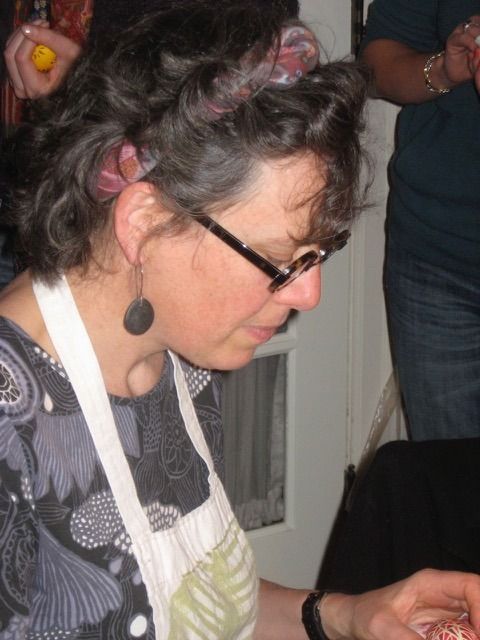
Julie decorating an egg at last year’s party.


What was the best part of making this book? The most challenging?
Best: This book was fun to work on from start to finish. The illustrations are loose, quick and free. (Although I painted many of the pages over and over again until I was satisfied with the result.)
I loved doing the research about chickens and about Ukrainian eggs. It was fun to paint, and it was good to work with the editor and art editor at Peachtree.

“This was the first painting I did to figure out the look of the book. P. Zonka is a Frisian Bantam. I kept P. Zonka looking that way but changed the flowers to reflect traditional Ukrainian egg designs.”
Challenging: I wanted to paint this book with Ukrainian dyes instead of paint, but the vivid colors couldn’t be reproduced faithfully enough. It was challenging for me to let go of that idea. Also, two words of the text were somehow lost in the printing process. When Gloria is introduced it should say: “It was his job to crow and he did it well.” I miss those words and hope that they will return in later printings!
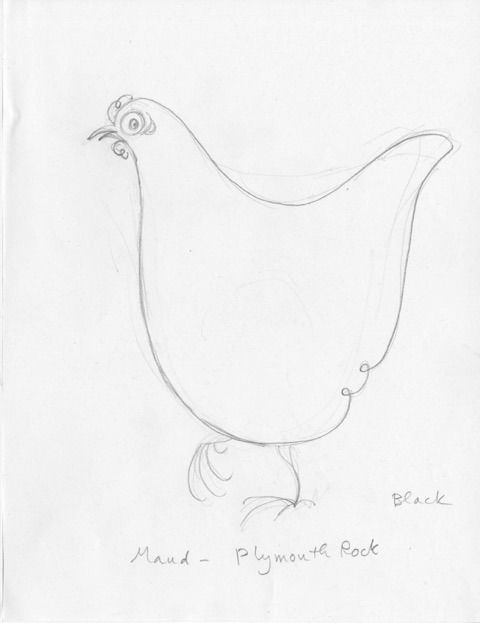
Character sketch of Maud.
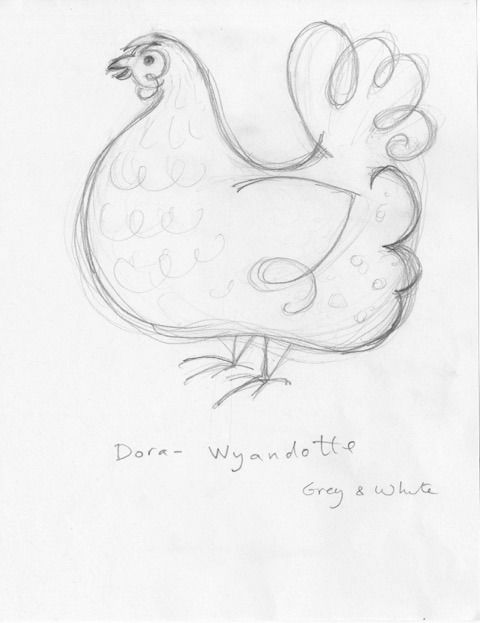
Character sketch of Dora.
What do you hope kids will take away from reading this story?
I hope that they will value the eccentrics among them, and the eccentricity within themselves. I hope that they will allow themselves to wander, explore and digress. I hope that they will try to lay (metaphorical) eggs from time to time!

* * *
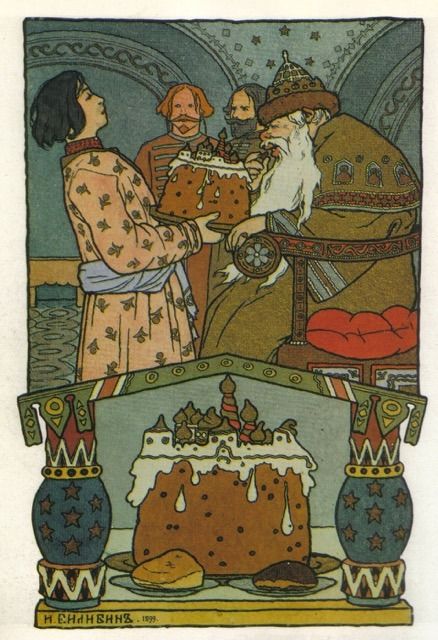
Russian cake illustration by Ivan Bilibin
♥ KULICH (EASTER COFFEE CAKE) RECIPE ♥
Julie found this recipe in Please to the Table: The Russian Cookbook by Anya von Bremzen and John Welchman (Workman Publishing, 1990). Kulich is a kind of traditional Easter bread eaten in countries such as Bulgaria, Romania, Ukraine and Serbia in addition to Russia. It is baked in a tall cylindrical tin (such as coffee or juice tins), and mainly eaten between Easter and Pentecost.
Just from the list of ingredients, I can tell this is probably really delicious (and Julie assures me it is). Any time you combine butter, honey, vanilla, almond extract, spices like nutmeg and cardamom, with brandy, Cointreau, almonds and golden raisins, you’re bound to create magic!

Ingredients:
- 1/2 cup milk
- 1-1/2 tablespoons honey
- 2 tablespoons vegetable oil
- 4-1/2 cups unbleached all-purpose flour, sifted twice
- 1 package active dry yeast
- 1/3 cup lukewarm water (105 to 115 degrees F)
- 9 large egg yolks
- 1 cup sugar
- 1/2 teaspoon freshly grated nutmeg
- 1/4 teaspoon ground cardamom
- 1 teaspoon vanilla extract
- 2 tablespoons Cointreau
- 2 tablespoons brandy
- Grated zest and juice of 1 orange
- 1-1/2 large vanilla beans, split lengthwise
- 12 tablespoons (1-1/2 sticks) unsalted butter, melted and cooled to lukewarm
- 1/2 cup golden raisins
- 1/2 cup finely chopped almonds
- 1/2 teaspoon almond extract
- 1 large egg white
Procedure:
1. In a medium-size saucepan, bring the milk to a boil over medium heat. Remove from the heat and add the honey and oil, stirring until the honey is dissolved.
2. Gradually add 1/2 cup of the flour, beating until mixture is completely smooth. Cool to lukewarm.
3. In a large bowl, add the yeast to the water, stir, and let stand until foamy, about 5 minutes.
4. Add the milk and flour mixture to the yeast and stir until smooth. Cover with a linen or cotton (not terry cloth) kitchen towel and let rise in a warm place until the sponge doubles in bulk, about 1 hour.
5. In a second bowl, beat the egg yolks and the sugar until thick and pale yellow. Add the nutmeg, cardamom, vanilla extract, Cointreau, brandy, orange zest, and orange juice and beat for a few more seconds.
6. Scrape out the seeds from the vanilla beans and add them to the yolk mixture. Add the butter, raisins, almonds, and almond extract.
7. With a clean dry beater, beat the egg white until it forms soft peaks and fold it into the egg yolk mixture.
8. Combine the yolk mixture with the risen sponge and mix gently but thoroughly. Using an electric mixer, gradually beat in the remaining 4 cups flour until you have a very smooth, loose dough. Transfer the dough to a clean, well-greased bowl, cover with plastic wrap, and let rise in a warm place until doubled in bulk, 1-1/2 hours.
9. Cut two 1-1/2-inch strips of parchment paper, each long enough to be molded down one side, then across the bottom and up the opposite side of a clean 2-pound coffee tin. The ends should extend above the top of the tin. Butter the tin and the strips, then set them into the tin crisscross to each other. Fold the ends over the outside of the tin.
10. Punch the dough down and place it in the tin. Let rise again, covered, until doubled in bulk, about 45 minutes.
11. While the dough is rising, preheat the oven to 325 degrees F.
12. Bake the kulich until it is golden brown and cake tester comes out clean, about 1 hour to 1 hour 10 minutes. Cool slightly, then carefully lift the kulich from the tin by pulling up on the ends of the parchment strips. Remove the parchment and let the kulich cool on a rack.
Makes 1 cake (serves 8)
* * *
♥ CONGRATULATIONS, JULIE! ♥
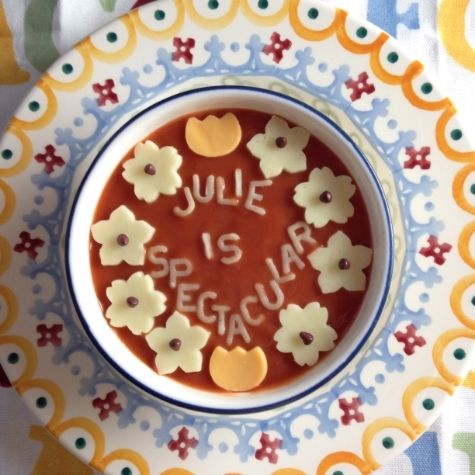
Today’s Special: P. Zonka Potage (liberally seasoned with dreams, beauty, and pluck)
* * *

P. ZONKA LAYS AN EGG
written and illustrated by Julie Paschkis
published by Peachtree Publishers, March 2015
Picture Book for ages 4-8, 32 pp.
***Starred Reviews from Kirkus, School Library Journal and Publishers Weekly***
♥ Find out more about Julie and her work at her Official Website, Mooshka (Patchwork Blog), Books Around the Table, and at Julie Paprika.
♥ Click on the link below to see Julie’s very cool Pysanky Egg Party Guide:
* * *

✿ SPECIAL BOOK GIVEAWAY!! ✿
Here’s a chance to win a free copy of this beautiful, life-affirming book. Believe me, if you’re winter weary and color starved, P. Zonka will wake you right up! To enter, simply leave a comment at this post suggesting a fitting first name for Ms. Zonka. What do you think the letter “P” should stand for? Giveaway deadline is midnight (EST) Sunday, March 8, 2015. Open to U.S. residents only, please. Good Cluck Luck! :)
—————————————————-
* Spreads from P. Zonka Lays An Egg posted by permission of the publisher, text and illustrations copyright © 2015 Julie Paschkis, published by Peachtree Publishers. All rights reserved.
Copyright © 2015 Jama Rattigan of Jama’s Alphabet Soup. All rights reserved.


